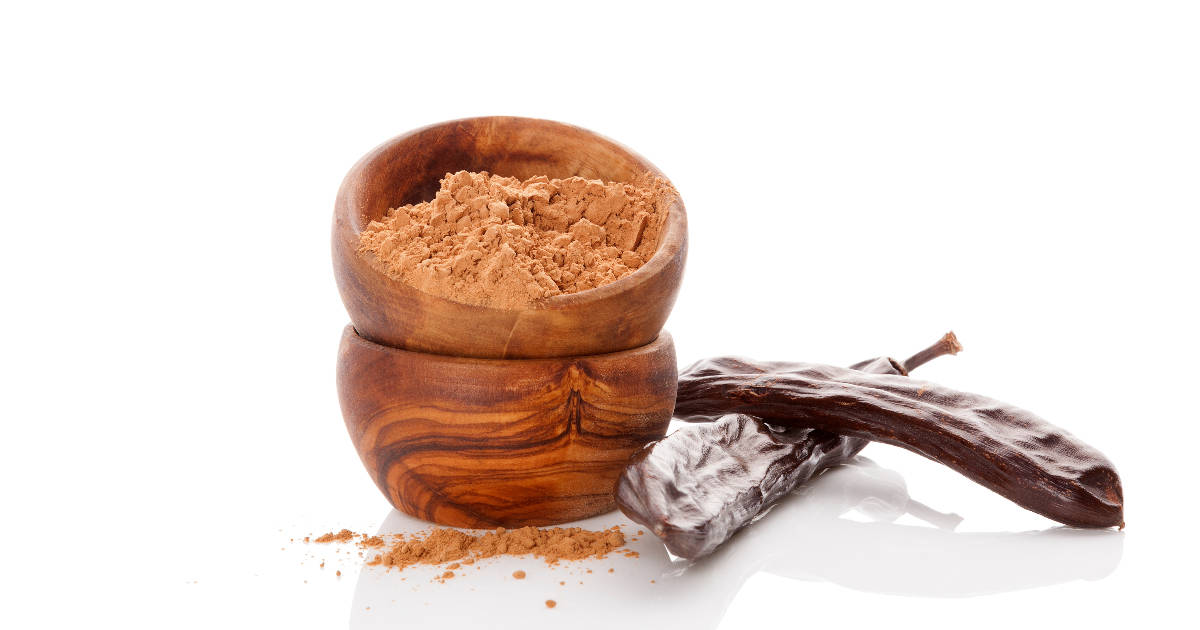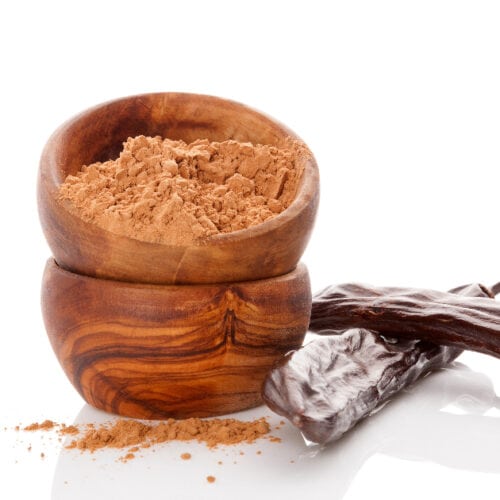Carob is a sweet and nutrient-dense tropical pod that can be turned into a chocolate-like powder used in various recipes.

Making homemade carob powder is rewarding but does require some effort to separate the seeds and fibers from the pods before grinding them into a fine flour.
Harvesting Carob Pods
Carob trees grow pods that ripen and fall to the ground in the late fall and early winter months. To harvest carob pods for powder:
- Locate carob trees growing in a clean environment and collect pods from the ground to avoid climbing. Pods acquire dirt and debris when they fall, so make sure to rinse them well.
- Use a large sack or basket to gather a sizeable quantity. Aim for at least a couple gallons worth of whole pods.
- For the highest quality powder, harvest pods that appear undamaged and avoid any that seem excessively hardened or dried out.
Separating the Seeds
Carob pods contain very hard black seeds running vertically down the center. To remove them:
- Soak the pods overnight in purified water with a bit of food-grade hydrogen peroxide added. This softens the pod texture for easier slicing.
- Slice vertically on both sides to expose the interior. Then slice down the middle lengthwise to reveal all the seeds.
- Remove seeds and place into a discard bowl. Add de-seeded pod pieces to a separate bowl.
This seed separation process is time-consuming but gets faster with practice. Expect to handle over 100 seeds for every 2 gallons of whole pods.
Key Takeaway: Soaking carob pods makes seed removal much easier compared to cutting into unsoaked hardened pods.
Dehydrating the Pods
Once seeds are removed, the pods need to be fully dehydrated before grinding into powder:
- Spread pod pieces evenly on mesh dehydrator sheets. Break larger sections into smaller pieces.
- Dehydrate at 115°F (46°C) for approximately 8 hours, checking for doneness. Pieces should be very dry and brittle, not pliable.
- Check over pieces and remove any remaining seeds or end pieces you may have missed.
Grinding Carob Powder
You now have dried, seedless carob pieces ready for grinding into powder:
- Working in small batches, add pieces to a high-powered blender. Aim for 1-2 cups at a time.
- Blend on highest speed until a fine, flour-like powder is achieved. Avoid over-blending as carob powder can heat up and lose quality.
- Store powder in sealed glass jars out of direct sunlight. Add a desiccant packet to help retain flavor and shelf life.
For a finer powder, sift through a mesh strainer after blending. But very fine carob powder has tendency to clump in storage, so a small grind is usually best for DIY homemade batches.
Key Takeaway: A food dehydrator and high-speed blender are essential appliances for DIY carob powder production.
Measurements and Math
As a helpful guideline, here is the approximate math for whole pods into powder:
- 2 gallons whole fresh carob pods
Equals 1 gallon dried pieces
Equals 16 cups dried pieces Equals 8 cups carob powder
Or more simply:
- 2 cups dried pieces = 1 cup carob powder
So for every 2 gallons of harvested pods, expect about 8 cups of homemade carob powder. Of course, pod size can vary but this gives you a ballpark estimate for planning batches.
Roasted vs. Raw Carob Powder
You can make either a raw or roasted carob powder depending on your preferences:
- For raw powder, follow the dehydrating and grinding directions above without using any heat during the process.
- For roasted powder, spread dried pieces evenly on a baking sheet and bake at 300°F (150°C), stirring occasionally, until lightly browned. Then grind as usual. Roasting adds richer flavor and aroma.
| Processing Method | Flavor | Nutrient Retention |
|---|---|---|
| Raw | Sweeter, beans-like | Higher |
| Roasted | Darker, caramelized | Lower |
Roasted carob powder has that signature sweet chocolate-like taste but does lose some nutritional value. Raw powder retains more nutrients and is also enzymatically active.
Using Your Homemade Carob Powder
When you make your own fresh carob powder it will be incredibly flavorful. Here are some ways to use it:
- Add to smoothies, shakes, porridges
- Mix into raw desserts like no-bake cookies, truffles, or energy bites
- Substitute for cocoa powder in any recipe
- Blend with nut butters and seeds into homemade snack bars
- Infuse into homemade plant-based milks and lattes
Since it is sweeter than cocoa powder, you likely won't need to add much extra sweetener to recipes when using DIY homemade carob powder.
| Benefits of Carob |
|---|
| - Rich in antioxidants |
| - Supports healthy digestion |
| - Alkalizing and mineralizing |
| - Contains vitamin E |
| - Prebiotic fiber feeds good gut microbiome |
Key Takeaway: Homemade raw carob powder makes for a nutritious chocolate substitute with its high antioxidant and prebiotic fiber content.
Storing Your Carob Powder
Proper storage is important for preserving the flavor and freshness of your homemade powder:
- Keep in sealed glass jars in a cool dark place away from light and heat. Adding a moisture-absorbing desiccant packet can help prevent clumping.
- The refrigerator is ideal for storage periods longer than 3-4 weeks.
- For long term storage up to 6 months, consider placing jars in the freezer.
When exposed to oxygen, heat and humidity, carob powder will eventually degrade in quality and nutrient content. Follow the storage tips above for best retention.

Homemade Carob Powder Recipe
Ingredients
- Fresh carob pods - Rinsed and harvested from carob trees when ripe
Instructions
- Harvest and rinse fresh carob pods. Soak overnight with added hydrogen peroxide.
- Slice pods vertically to remove interior seeds. Reserve pod pieces.
- Dehydrate pod pieces 8+ hours until very dry and brittle.
- Working in small batches, blend dried pieces into a fine powder.
- Store homemade carob powder in airtight jars away from light/heat.
Notes
FAQs
Can you make locust bean gum from carob pods?
No, locust bean gum requires intensive industrial processing and machines to produce. Homemade carob powder uses the edible pods, not the seeds that are used for gum production.
Is there a way to speed up the seed separation process?
If gathering a large quantity of pods, consider getting help. It's a time-consuming task best tackled with an extra set of hands. But other than that, there are no shortcuts unfortunately!
How long does homemade carob powder last?
When stored properly in airtight jars in the freezer, the powder can keep for 6-12 months before flavor and nutrients degrade. Always smell and taste test older batches before use.
Conclusion
Producing homemade carob powder is incredibly rewarding and allows you full control over the freshness and quality.
While labor-intensive, it provides satisfaction akin to other DIY wild harvested foods.

